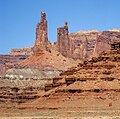| Monster Tower | |
|---|---|
 Monster Tower upper right, south aspect | |
| Highest point | |
| Elevation | 5,835 ft (1,779 m) [1] |
| Prominence | 395 ft (120 m) [1] |
| Parent peak | Aztec Butte (6,312 ft) [1] |
| Isolation | 3.91 mi (6.29 km) [2] |
| Coordinates | 38°23′22″N109°50′15″W / 38.389572°N 109.837446°W [1] |
| Geography | |
| Country | United States |
| State | Utah |
| County | San Juan |
| Protected area | Canyonlands National Park |
| Parent range | Colorado Plateau |
| Topo map | USGS Musselman Arch |
| Geology | |
| Rock age | Late Triassic |
| Rock type | Wingate Sandstone |
| Climbing | |
| First ascent | December 26, 1963 |
| Easiest route | class 5.11 Climbing [2] |
Monster Tower is a 600-foot (180-meter) tall sandstone tower located on the Island in the Sky District of Canyonlands National Park, in San Juan County, Utah, United States.












